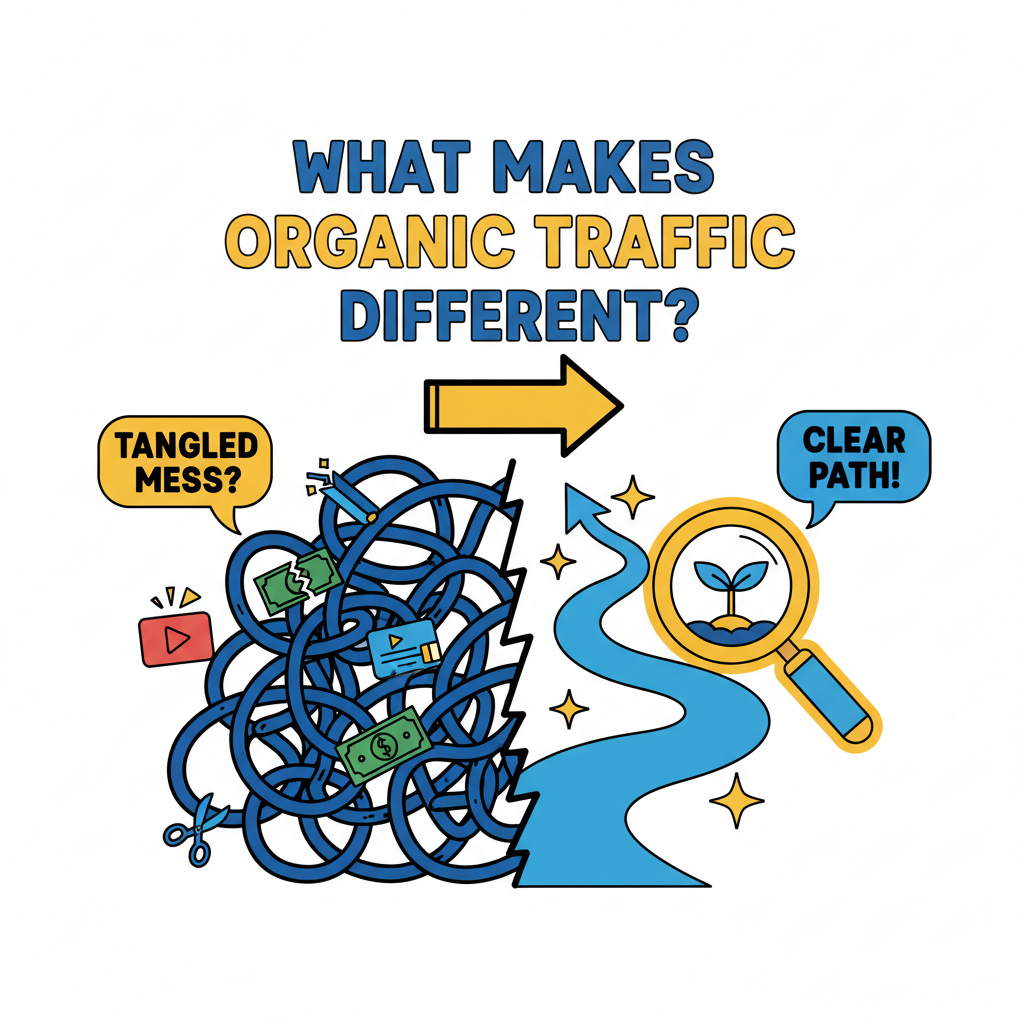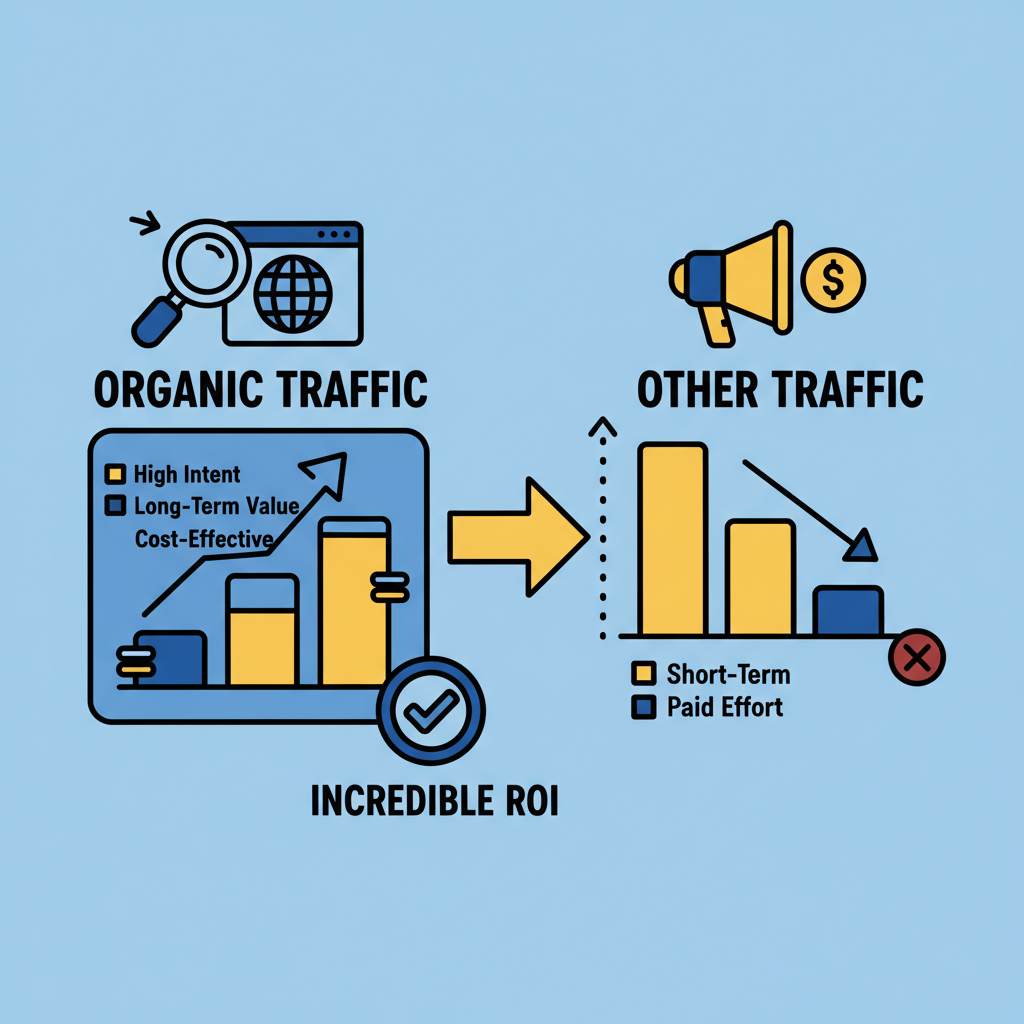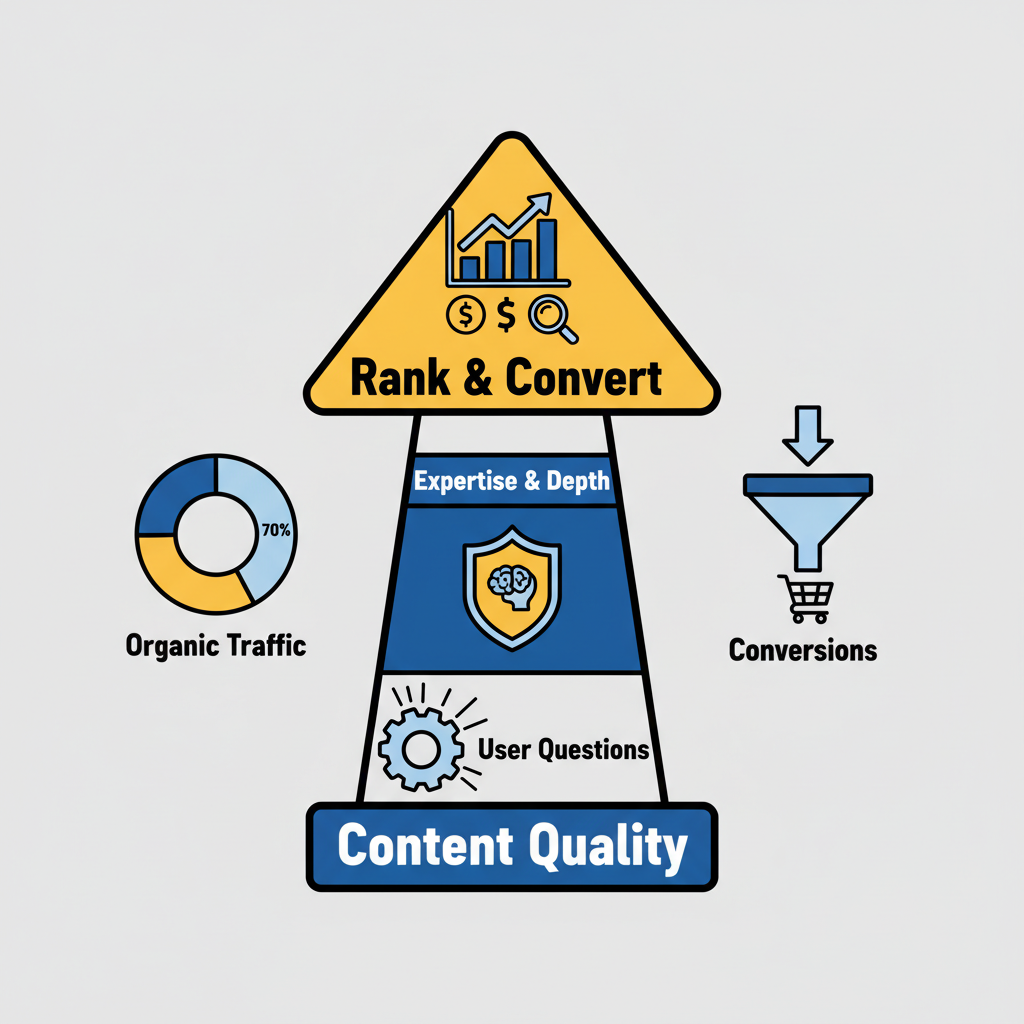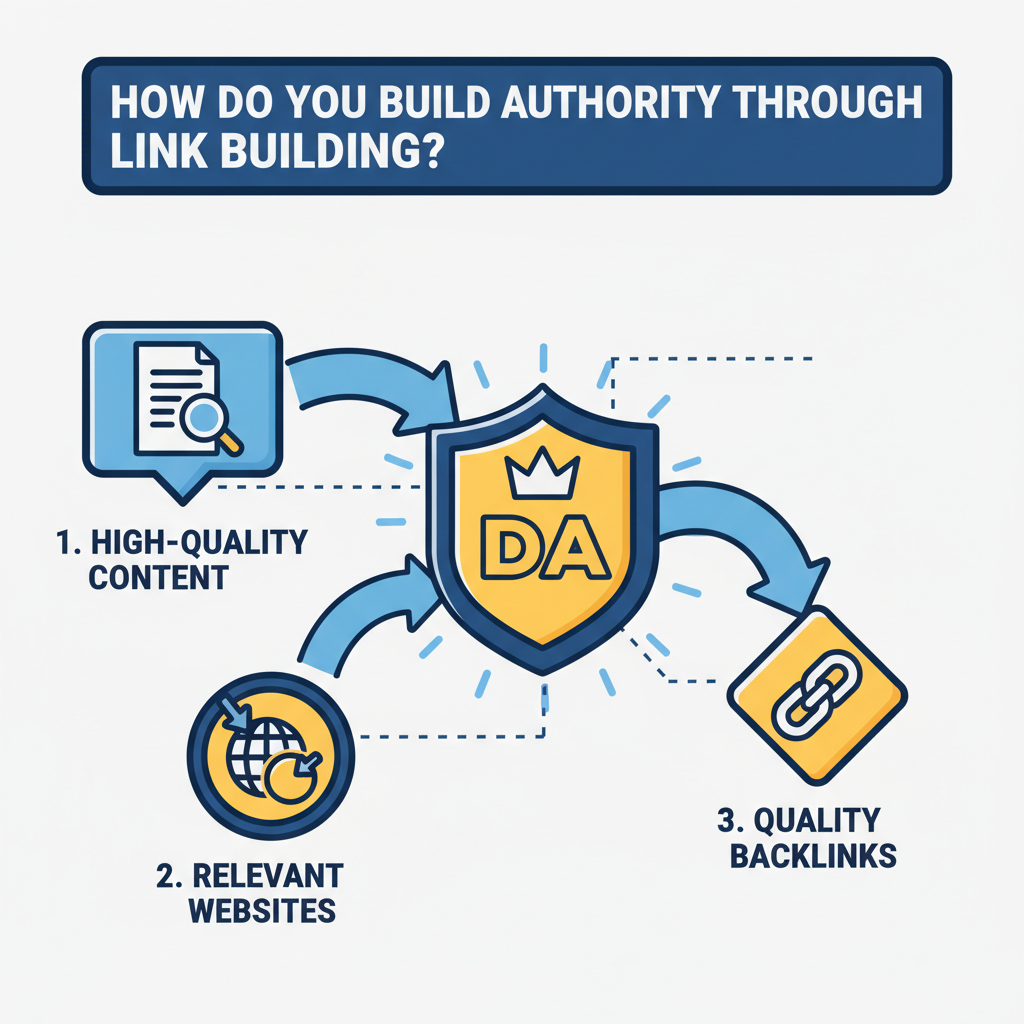What Makes Organic Traffic Different from Other Traffic Sources?
Posted by
How to Build Sustainable Organic Traffic Growth That Converts

Building organic traffic isn't just about getting more visitors to your website. It's about attracting the right audience who will engage with your content, trust your brand, and ultimately become customers. While paid advertising can deliver quick results, organic traffic provides the foundation for long-term digital success. This comprehensive guide will show you exactly how to create a sustainable organic traffic strategy that not only increases your visitor numbers but also drives meaningful business results.
What Makes Organic Traffic Different from Other Traffic Sources?

Organic traffic represents visitors who find your website through unpaid search engine results. Unlike paid advertising or social media traffic, these visitors actively searched for information, products, or services related to your business. This intent-driven behavior makes organic traffic incredibly valuable for conversions and long-term customer relationships.
The key difference lies in user intent and trust. When someone clicks on your website from search results, they've already demonstrated interest in your topic. They trust search engines to provide relevant results, which transfers credibility to your site. This natural discovery process creates a higher likelihood of engagement compared to interruption-based marketing methods.
Understanding what makes organic traffic different from other traffic sources helps you appreciate why it should be a cornerstone of your digital marketing strategy. The compound effect of organic growth means your efforts today continue delivering results months and years into the future.
How Do You Research and Target the Right Keywords for Organic Growth?
Effective keyword research forms the backbone of successful organic traffic generation. Start by identifying topics your target audience actively searches for, then expand into specific keyword variations that match different stages of the buyer's journey.
Begin with seed keywords related to your business, then use tools like Google Keyword Planner, Ahrefs, or SEMrush to discover related terms with good search volume and manageable competition. Focus on long-tail keywords that reflect specific user intent rather than broad, highly competitive terms that are difficult to rank for initially.
Consider search intent behind each keyword. Informational queries (how-to guides, explanations) attract users in the research phase, while transactional keywords (buy, best, review) target users ready to make decisions. Comprehensive keyword research strategies ensure you capture traffic at every stage of the customer journey.
Mapping Keywords to Content Strategy
Once you've identified target keywords, organize them into content clusters around main topics. This approach helps search engines understand your site's expertise while providing comprehensive coverage of subjects your audience cares about. Create pillar content for broad topics, then develop supporting articles that target specific long-tail variations.
| Keyword Type | Search Intent | Content Format | Traffic Potential |
|---|---|---|---|
| Informational | Learning/Research | Blog posts, guides | High volume, lower conversion |
| Navigational | Finding specific site | Landing pages | Medium volume, high relevance |
| Transactional | Ready to buy | Product pages, reviews | Lower volume, high conversion |
| Commercial | Comparing options | Comparison posts | Medium volume, good conversion |
How Do You Create Content That Ranks and Converts?

Content quality directly impacts your ability to attract and retain organic traffic. Search engines prioritize content that thoroughly answers user questions while providing a positive user experience. Focus on creating comprehensive, well-researched articles that demonstrate expertise in your field.
Structure your content with clear headings, bullet points, and logical flow that makes information easy to scan and digest. Include relevant examples, data, and actionable advice that readers can implement immediately. This approach increases engagement metrics like time on page and reduces bounce rates, which are positive ranking signals.
Optimize your content for both search engines and human readers. Include target keywords naturally throughout the text, but prioritize readability and value over keyword density. Understanding SEO fundamentals helps you balance optimization with user experience effectively.
Building Content That Establishes Authority
Authority content goes beyond basic keyword targeting to establish your brand as a trusted resource in your industry. Create in-depth guides, case studies, and research-backed articles that other websites want to reference and link to. These authoritative pieces attract high-quality backlinks, which significantly boost your organic search rankings.
Regular content updates also signal freshness to search engines while keeping information current for your audience. Review and refresh your top-performing content quarterly, adding new insights, updating statistics, and expanding sections that resonate with readers.
What Technical Elements Support Organic Traffic Growth?
Technical SEO provides the foundation that allows your content to perform well in search results. Start with website speed optimization, as page loading time directly affects both user experience and search rankings. Compress images, minimize code, and choose reliable hosting to ensure fast load times across all devices.
Mobile responsiveness is non-negotiable for organic traffic success. With mobile-first indexing, Google primarily uses the mobile version of your site for ranking decisions. Ensure your website displays properly and loads quickly on smartphones and tablets.
Create an XML sitemap and submit it to Google Search Console to help search engines discover and index your content efficiently. Fix any crawl errors, broken links, or duplicate content issues that might prevent search engines from properly understanding your site structure.
Optimizing for Core Web Vitals
Google's Core Web Vitals measure user experience through loading performance, interactivity, and visual stability. These metrics increasingly influence search rankings, making technical optimization essential for organic growth.
Focus on improving Largest Contentful Paint (LCP) by optimizing your largest page elements, First Input Delay (FID) by minimizing JavaScript execution time, and Cumulative Layout Shift (CLS) by ensuring stable page layouts. According to Google's Web Vitals documentation, sites meeting these thresholds see improved search performance and user satisfaction.
How Do You Build Authority Through Link Building?

Link building remains one of the most important factors for organic traffic growth. Quality backlinks from relevant, authoritative websites signal to search engines that your content is valuable and trustworthy. Focus on earning links through high-quality content rather than manipulative tactics that can result in penalties.
Create linkable assets like original research, comprehensive guides, tools, or infographics that other websites naturally want to reference. Reach out to industry publications, bloggers, and websites in your niche to share your valuable content when it's genuinely relevant to their audience.
Guest posting on reputable websites in your industry provides opportunities to share expertise while earning quality backlinks. Ensure your guest content offers genuine value and follows the host site's guidelines rather than focusing solely on link acquisition.
Leveraging Internal Linking for SEO Power
Internal linking helps distribute authority throughout your website while improving user navigation. Link to relevant pages using descriptive anchor text that helps both users and search engines understand the linked content's topic.
Strategic internal linking can boost the ranking potential of important pages by directing link equity from high-performing content. Implementing effective blog post structures includes natural internal linking opportunities that enhance both SEO and user experience.
How Do You Measure and Optimize Organic Traffic Performance?
Tracking organic traffic performance requires monitoring multiple metrics beyond simple visitor counts. Use Google Analytics to measure organic sessions, bounce rate, pages per session, and conversion rates from organic traffic. These metrics reveal both the quantity and quality of your organic visitors.
Google Search Console provides invaluable insights into your search performance, showing which keywords drive traffic, your average rankings, and click-through rates. Monitor these metrics regularly to identify opportunities for improvement and track the impact of your optimization efforts.
Set up conversion tracking to understand how organic traffic contributes to your business goals. Whether you're measuring email signups, product purchases, or contact form submissions, connecting organic traffic to actual business outcomes helps justify your SEO investment and guide future strategy decisions.
Identifying Growth Opportunities
Regular performance analysis reveals patterns and opportunities for accelerating organic growth. Look for keywords where you rank on page two of search results, as these represent quick wins with focused optimization efforts. Similarly, identify high-performing content that could benefit from expansion or internal linking improvements.
According to HubSpot's marketing statistics, companies that blog regularly receive 55% more website visitors than those that don't, highlighting the compound effect of consistent content creation on organic traffic growth.
How Do You Scale Your Organic Traffic Strategy?
Scaling organic traffic requires systematic approaches that maintain quality while increasing content production and optimization efforts. Develop content templates and processes that ensure consistency across all your organic traffic initiatives. Document successful strategies so they can be replicated and improved over time.
Consider implementing fast SEO techniques that accelerate your organic growth timeline while maintaining sustainable practices. Automation tools can help with keyword research, content optimization, and performance monitoring, allowing you to focus on strategy and high-value activities.
Build a content calendar that balances different types of content, from quick-win topics to comprehensive authority pieces. This approach ensures steady organic traffic growth while building long-term domain authority and topical expertise.
Conclusion
Building sustainable organic traffic requires a comprehensive approach that combines strategic keyword targeting, high-quality content creation, technical optimization, and consistent performance monitoring. By focusing on user intent and providing genuine value, you create a foundation for long-term organic growth that continues delivering results over time.
The key to success lies in understanding that organic traffic isn't just about rankings or visitor numbers. It's about attracting the right audience who will engage with your content and convert into customers. Start implementing these strategies systematically, measuring your progress, and refining your approach based on data and results.
Ready to accelerate your organic traffic growth? Fast SEO Fix provides the tools and expertise you need to implement these strategies effectively and see results faster than traditional SEO approaches.